Organizational Management Report: Functions, Culture, Mistakes
VerifiedAdded on 2020/03/04
|9
|2084
|78
Report
AI Summary
This report delves into the core principles of organizational management, encompassing the four primary functions: planning, organizing, leading, and controlling. It examines how these functions operate within a business context, including a hypothetical scenario within a multinational clothing corporation. The report also analyzes the nature of management culture, exploring elements such as power, role, task, and person cultures, with a specific case study of Kentucky Fried Chicken (KFC) and its cultural web. Furthermore, the report identifies and discusses common communication mistakes made by managers, providing insights into their potential impact on organizational performance. The report concludes with a list of references for further reading.
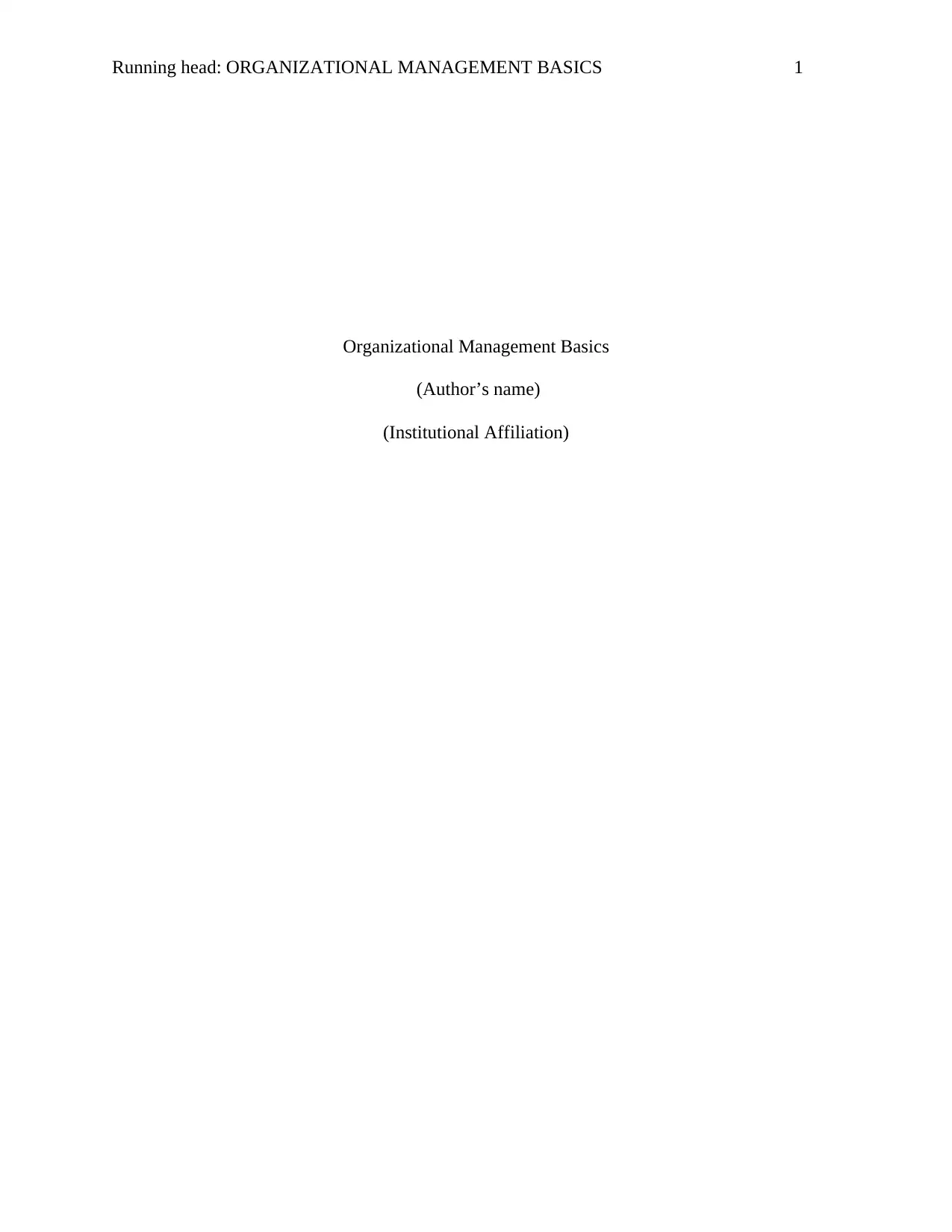
Running head: ORGANIZATIONAL MANAGEMENT BASICS 1
Organizational Management Basics
(Author’s name)
(Institutional Affiliation)
Organizational Management Basics
(Author’s name)
(Institutional Affiliation)
Paraphrase This Document
Need a fresh take? Get an instant paraphrase of this document with our AI Paraphraser
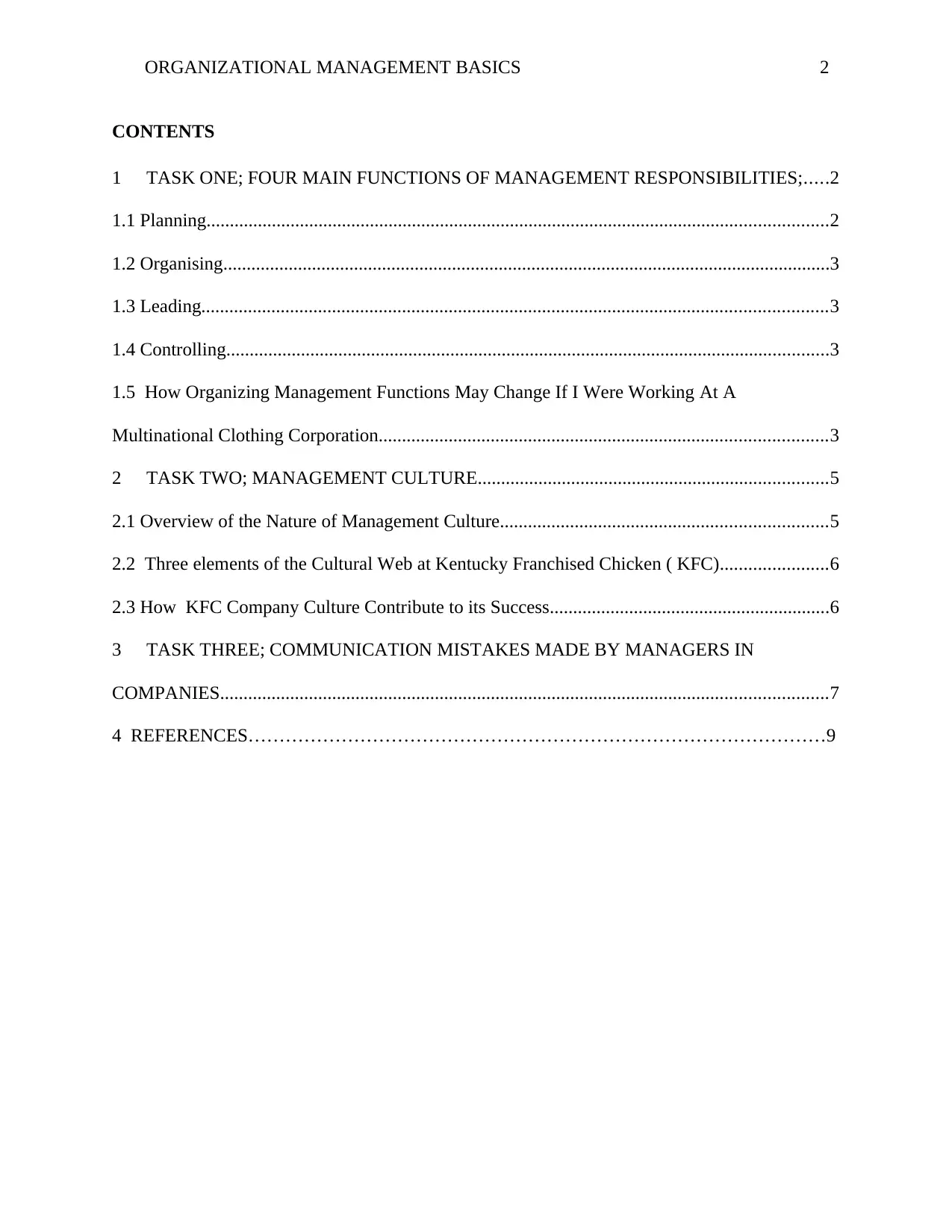
ORGANIZATIONAL MANAGEMENT BASICS 2
CONTENTS
1 TASK ONE; FOUR MAIN FUNCTIONS OF MANAGEMENT RESPONSIBILITIES;.....2
1.1 Planning.....................................................................................................................................2
1.2 Organising..................................................................................................................................3
1.3 Leading......................................................................................................................................3
1.4 Controlling.................................................................................................................................3
1.5 How Organizing Management Functions May Change If I Were Working At A
Multinational Clothing Corporation................................................................................................3
2 TASK TWO; MANAGEMENT CULTURE...........................................................................5
2.1 Overview of the Nature of Management Culture......................................................................5
2.2 Three elements of the Cultural Web at Kentucky Franchised Chicken ( KFC).......................6
2.3 How KFC Company Culture Contribute to its Success............................................................6
3 TASK THREE; COMMUNICATION MISTAKES MADE BY MANAGERS IN
COMPANIES..................................................................................................................................7
4 REFERENCES…………………………………………………………………………………9
CONTENTS
1 TASK ONE; FOUR MAIN FUNCTIONS OF MANAGEMENT RESPONSIBILITIES;.....2
1.1 Planning.....................................................................................................................................2
1.2 Organising..................................................................................................................................3
1.3 Leading......................................................................................................................................3
1.4 Controlling.................................................................................................................................3
1.5 How Organizing Management Functions May Change If I Were Working At A
Multinational Clothing Corporation................................................................................................3
2 TASK TWO; MANAGEMENT CULTURE...........................................................................5
2.1 Overview of the Nature of Management Culture......................................................................5
2.2 Three elements of the Cultural Web at Kentucky Franchised Chicken ( KFC).......................6
2.3 How KFC Company Culture Contribute to its Success............................................................6
3 TASK THREE; COMMUNICATION MISTAKES MADE BY MANAGERS IN
COMPANIES..................................................................................................................................7
4 REFERENCES…………………………………………………………………………………9
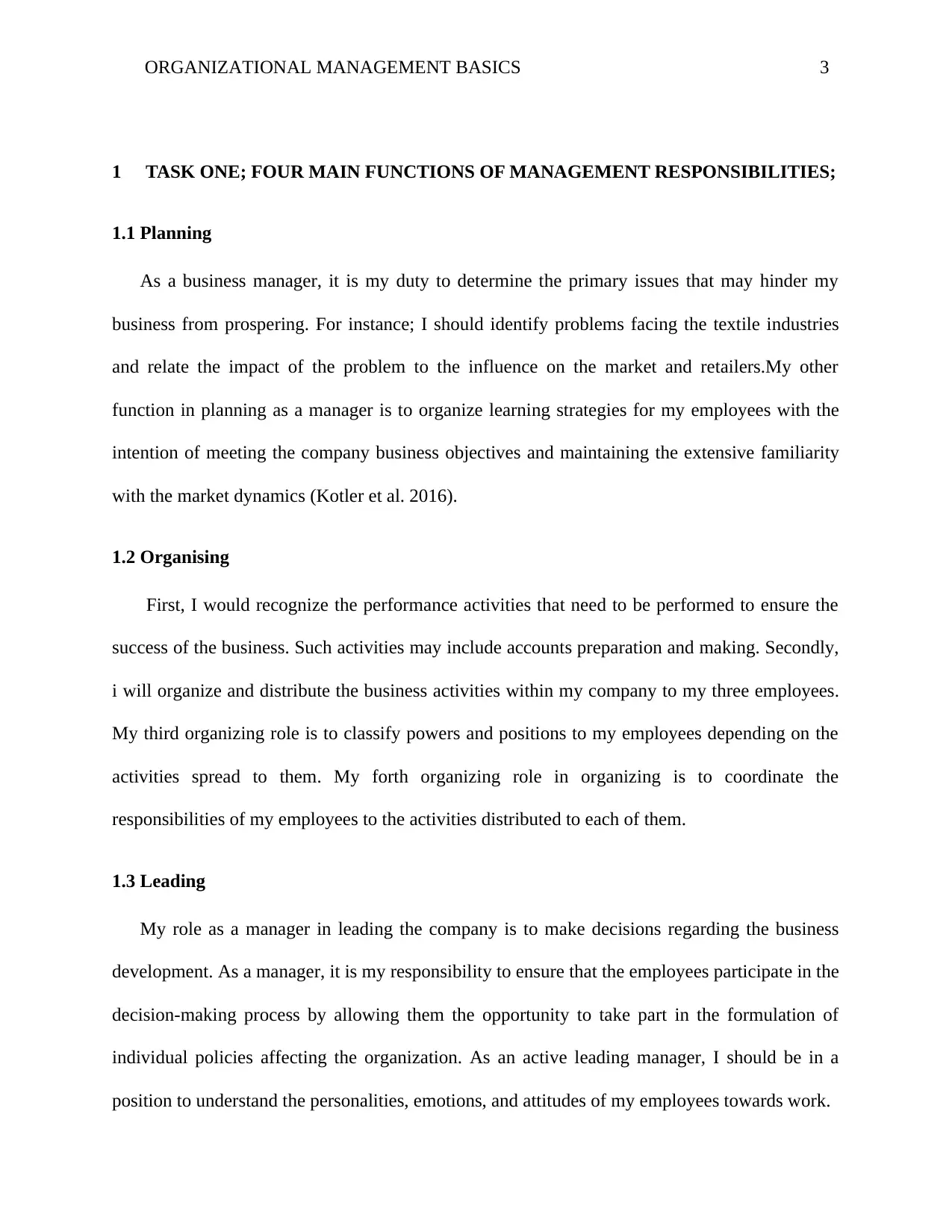
ORGANIZATIONAL MANAGEMENT BASICS 3
1 TASK ONE; FOUR MAIN FUNCTIONS OF MANAGEMENT RESPONSIBILITIES;
1.1 Planning
As a business manager, it is my duty to determine the primary issues that may hinder my
business from prospering. For instance; I should identify problems facing the textile industries
and relate the impact of the problem to the influence on the market and retailers.My other
function in planning as a manager is to organize learning strategies for my employees with the
intention of meeting the company business objectives and maintaining the extensive familiarity
with the market dynamics (Kotler et al. 2016).
1.2 Organising
First, I would recognize the performance activities that need to be performed to ensure the
success of the business. Such activities may include accounts preparation and making. Secondly,
i will organize and distribute the business activities within my company to my three employees.
My third organizing role is to classify powers and positions to my employees depending on the
activities spread to them. My forth organizing role in organizing is to coordinate the
responsibilities of my employees to the activities distributed to each of them.
1.3 Leading
My role as a manager in leading the company is to make decisions regarding the business
development. As a manager, it is my responsibility to ensure that the employees participate in the
decision-making process by allowing them the opportunity to take part in the formulation of
individual policies affecting the organization. As an active leading manager, I should be in a
position to understand the personalities, emotions, and attitudes of my employees towards work.
1 TASK ONE; FOUR MAIN FUNCTIONS OF MANAGEMENT RESPONSIBILITIES;
1.1 Planning
As a business manager, it is my duty to determine the primary issues that may hinder my
business from prospering. For instance; I should identify problems facing the textile industries
and relate the impact of the problem to the influence on the market and retailers.My other
function in planning as a manager is to organize learning strategies for my employees with the
intention of meeting the company business objectives and maintaining the extensive familiarity
with the market dynamics (Kotler et al. 2016).
1.2 Organising
First, I would recognize the performance activities that need to be performed to ensure the
success of the business. Such activities may include accounts preparation and making. Secondly,
i will organize and distribute the business activities within my company to my three employees.
My third organizing role is to classify powers and positions to my employees depending on the
activities spread to them. My forth organizing role in organizing is to coordinate the
responsibilities of my employees to the activities distributed to each of them.
1.3 Leading
My role as a manager in leading the company is to make decisions regarding the business
development. As a manager, it is my responsibility to ensure that the employees participate in the
decision-making process by allowing them the opportunity to take part in the formulation of
individual policies affecting the organization. As an active leading manager, I should be in a
position to understand the personalities, emotions, and attitudes of my employees towards work.
⊘ This is a preview!⊘
Do you want full access?
Subscribe today to unlock all pages.

Trusted by 1+ million students worldwide
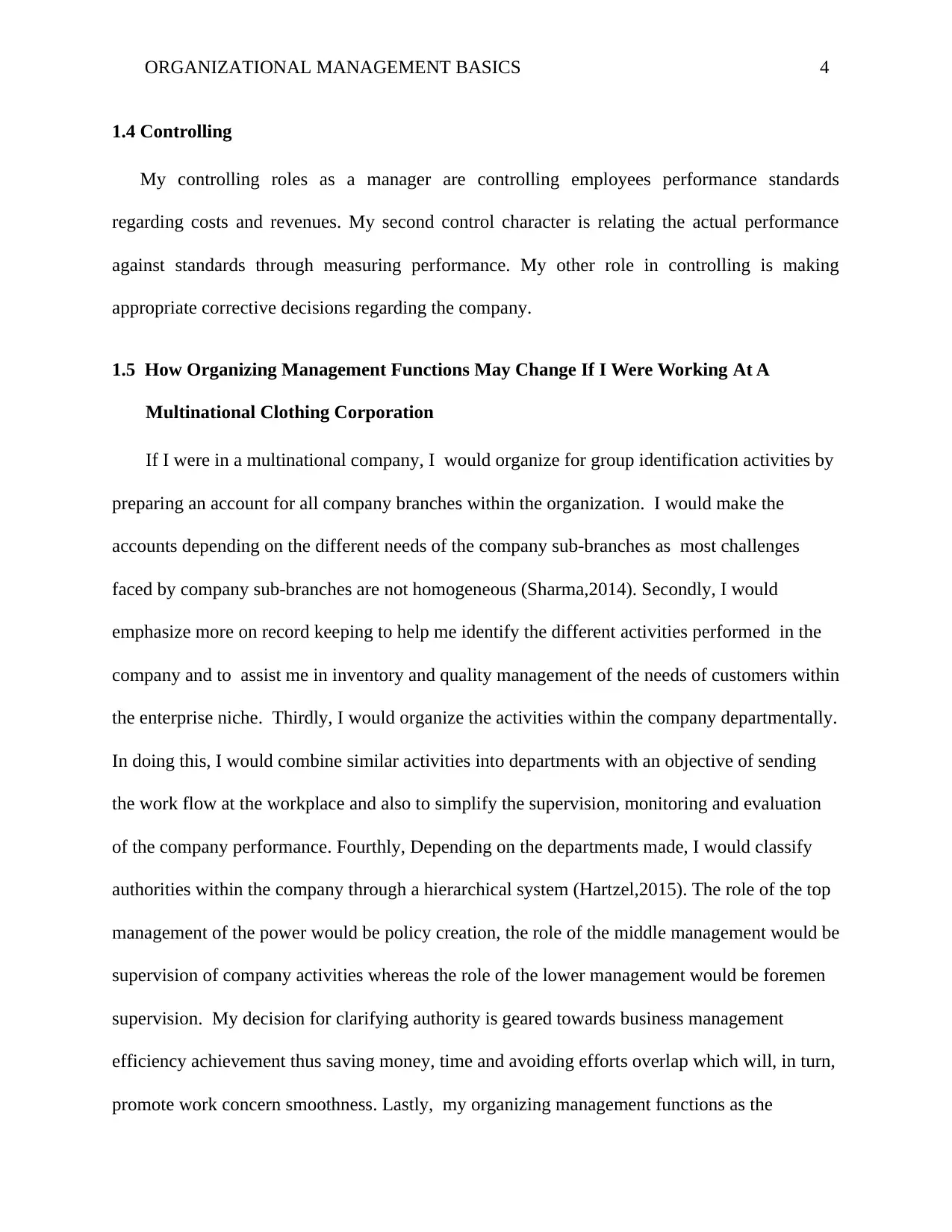
ORGANIZATIONAL MANAGEMENT BASICS 4
1.4 Controlling
My controlling roles as a manager are controlling employees performance standards
regarding costs and revenues. My second control character is relating the actual performance
against standards through measuring performance. My other role in controlling is making
appropriate corrective decisions regarding the company.
1.5 How Organizing Management Functions May Change If I Were Working At A
Multinational Clothing Corporation
If I were in a multinational company, I would organize for group identification activities by
preparing an account for all company branches within the organization. I would make the
accounts depending on the different needs of the company sub-branches as most challenges
faced by company sub-branches are not homogeneous (Sharma,2014). Secondly, I would
emphasize more on record keeping to help me identify the different activities performed in the
company and to assist me in inventory and quality management of the needs of customers within
the enterprise niche. Thirdly, I would organize the activities within the company departmentally.
In doing this, I would combine similar activities into departments with an objective of sending
the work flow at the workplace and also to simplify the supervision, monitoring and evaluation
of the company performance. Fourthly, Depending on the departments made, I would classify
authorities within the company through a hierarchical system (Hartzel,2015). The role of the top
management of the power would be policy creation, the role of the middle management would be
supervision of company activities whereas the role of the lower management would be foremen
supervision. My decision for clarifying authority is geared towards business management
efficiency achievement thus saving money, time and avoiding efforts overlap which will, in turn,
promote work concern smoothness. Lastly, my organizing management functions as the
1.4 Controlling
My controlling roles as a manager are controlling employees performance standards
regarding costs and revenues. My second control character is relating the actual performance
against standards through measuring performance. My other role in controlling is making
appropriate corrective decisions regarding the company.
1.5 How Organizing Management Functions May Change If I Were Working At A
Multinational Clothing Corporation
If I were in a multinational company, I would organize for group identification activities by
preparing an account for all company branches within the organization. I would make the
accounts depending on the different needs of the company sub-branches as most challenges
faced by company sub-branches are not homogeneous (Sharma,2014). Secondly, I would
emphasize more on record keeping to help me identify the different activities performed in the
company and to assist me in inventory and quality management of the needs of customers within
the enterprise niche. Thirdly, I would organize the activities within the company departmentally.
In doing this, I would combine similar activities into departments with an objective of sending
the work flow at the workplace and also to simplify the supervision, monitoring and evaluation
of the company performance. Fourthly, Depending on the departments made, I would classify
authorities within the company through a hierarchical system (Hartzel,2015). The role of the top
management of the power would be policy creation, the role of the middle management would be
supervision of company activities whereas the role of the lower management would be foremen
supervision. My decision for clarifying authority is geared towards business management
efficiency achievement thus saving money, time and avoiding efforts overlap which will, in turn,
promote work concern smoothness. Lastly, my organizing management functions as the
Paraphrase This Document
Need a fresh take? Get an instant paraphrase of this document with our AI Paraphraser
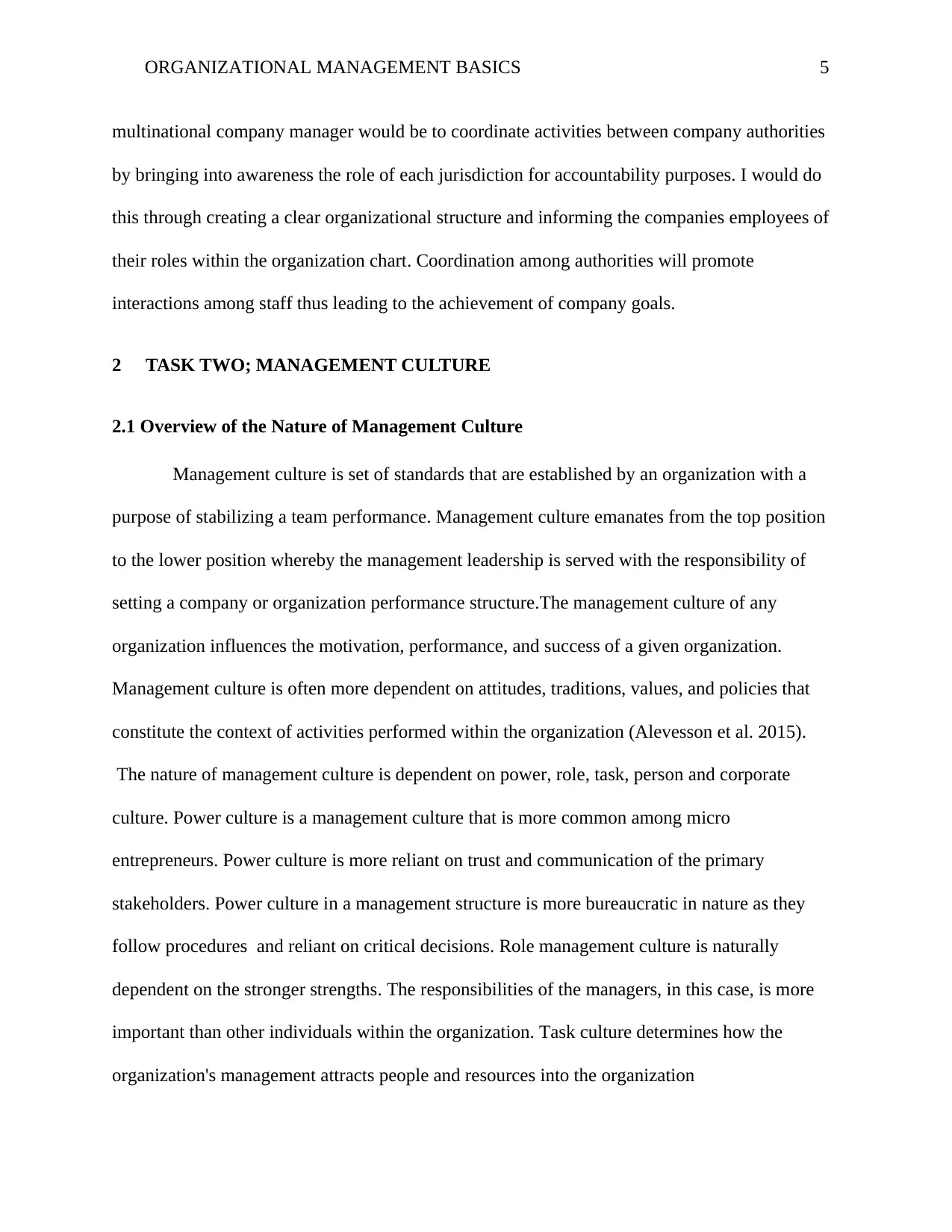
ORGANIZATIONAL MANAGEMENT BASICS 5
multinational company manager would be to coordinate activities between company authorities
by bringing into awareness the role of each jurisdiction for accountability purposes. I would do
this through creating a clear organizational structure and informing the companies employees of
their roles within the organization chart. Coordination among authorities will promote
interactions among staff thus leading to the achievement of company goals.
2 TASK TWO; MANAGEMENT CULTURE
2.1 Overview of the Nature of Management Culture
Management culture is set of standards that are established by an organization with a
purpose of stabilizing a team performance. Management culture emanates from the top position
to the lower position whereby the management leadership is served with the responsibility of
setting a company or organization performance structure.The management culture of any
organization influences the motivation, performance, and success of a given organization.
Management culture is often more dependent on attitudes, traditions, values, and policies that
constitute the context of activities performed within the organization (Alevesson et al. 2015).
The nature of management culture is dependent on power, role, task, person and corporate
culture. Power culture is a management culture that is more common among micro
entrepreneurs. Power culture is more reliant on trust and communication of the primary
stakeholders. Power culture in a management structure is more bureaucratic in nature as they
follow procedures and reliant on critical decisions. Role management culture is naturally
dependent on the stronger strengths. The responsibilities of the managers, in this case, is more
important than other individuals within the organization. Task culture determines how the
organization's management attracts people and resources into the organization
multinational company manager would be to coordinate activities between company authorities
by bringing into awareness the role of each jurisdiction for accountability purposes. I would do
this through creating a clear organizational structure and informing the companies employees of
their roles within the organization chart. Coordination among authorities will promote
interactions among staff thus leading to the achievement of company goals.
2 TASK TWO; MANAGEMENT CULTURE
2.1 Overview of the Nature of Management Culture
Management culture is set of standards that are established by an organization with a
purpose of stabilizing a team performance. Management culture emanates from the top position
to the lower position whereby the management leadership is served with the responsibility of
setting a company or organization performance structure.The management culture of any
organization influences the motivation, performance, and success of a given organization.
Management culture is often more dependent on attitudes, traditions, values, and policies that
constitute the context of activities performed within the organization (Alevesson et al. 2015).
The nature of management culture is dependent on power, role, task, person and corporate
culture. Power culture is a management culture that is more common among micro
entrepreneurs. Power culture is more reliant on trust and communication of the primary
stakeholders. Power culture in a management structure is more bureaucratic in nature as they
follow procedures and reliant on critical decisions. Role management culture is naturally
dependent on the stronger strengths. The responsibilities of the managers, in this case, is more
important than other individuals within the organization. Task culture determines how the
organization's management attracts people and resources into the organization
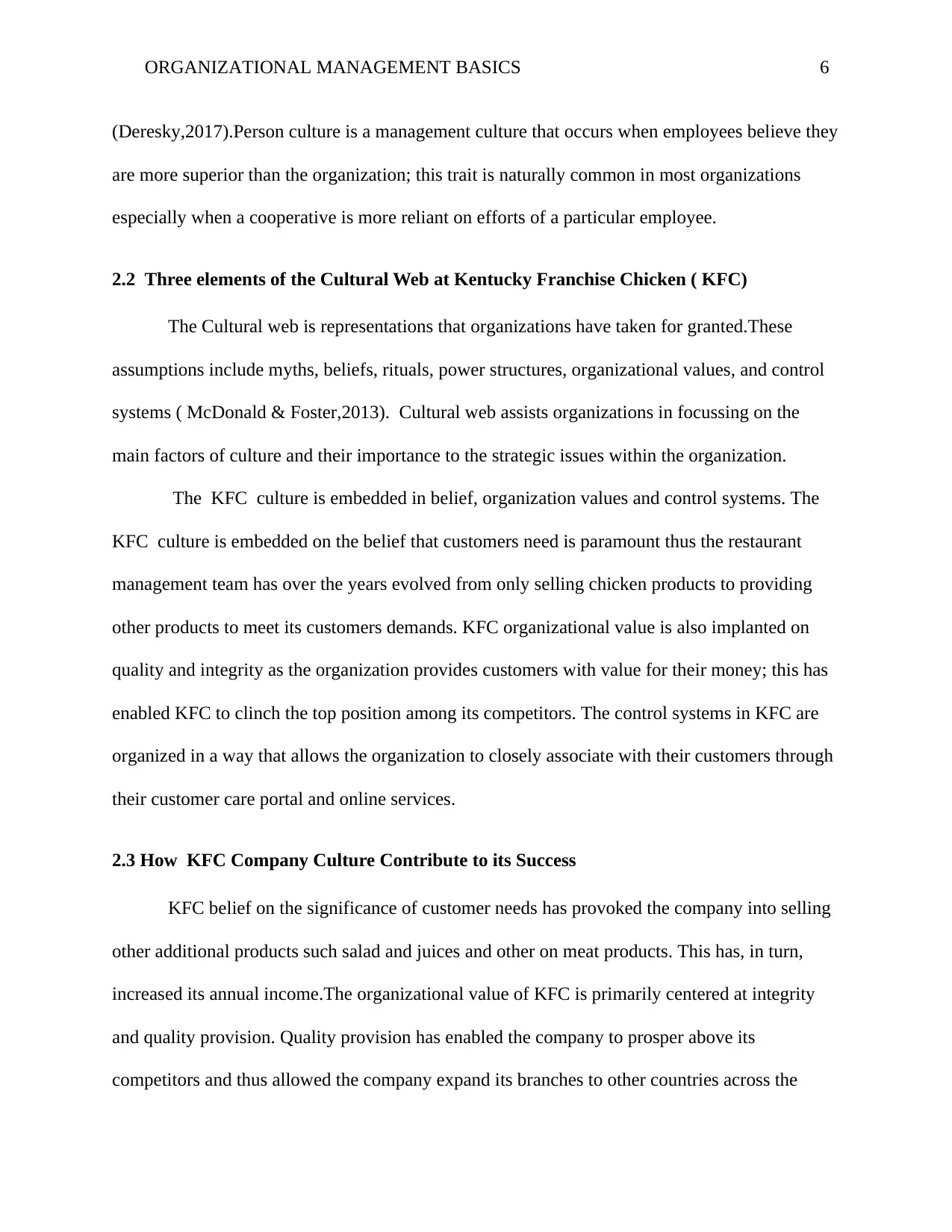
ORGANIZATIONAL MANAGEMENT BASICS 6
(Deresky,2017).Person culture is a management culture that occurs when employees believe they
are more superior than the organization; this trait is naturally common in most organizations
especially when a cooperative is more reliant on efforts of a particular employee.
2.2 Three elements of the Cultural Web at Kentucky Franchise Chicken ( KFC)
The Cultural web is representations that organizations have taken for granted.These
assumptions include myths, beliefs, rituals, power structures, organizational values, and control
systems ( McDonald & Foster,2013). Cultural web assists organizations in focussing on the
main factors of culture and their importance to the strategic issues within the organization.
The KFC culture is embedded in belief, organization values and control systems. The
KFC culture is embedded on the belief that customers need is paramount thus the restaurant
management team has over the years evolved from only selling chicken products to providing
other products to meet its customers demands. KFC organizational value is also implanted on
quality and integrity as the organization provides customers with value for their money; this has
enabled KFC to clinch the top position among its competitors. The control systems in KFC are
organized in a way that allows the organization to closely associate with their customers through
their customer care portal and online services.
2.3 How KFC Company Culture Contribute to its Success
KFC belief on the significance of customer needs has provoked the company into selling
other additional products such salad and juices and other on meat products. This has, in turn,
increased its annual income.The organizational value of KFC is primarily centered at integrity
and quality provision. Quality provision has enabled the company to prosper above its
competitors and thus allowed the company expand its branches to other countries across the
(Deresky,2017).Person culture is a management culture that occurs when employees believe they
are more superior than the organization; this trait is naturally common in most organizations
especially when a cooperative is more reliant on efforts of a particular employee.
2.2 Three elements of the Cultural Web at Kentucky Franchise Chicken ( KFC)
The Cultural web is representations that organizations have taken for granted.These
assumptions include myths, beliefs, rituals, power structures, organizational values, and control
systems ( McDonald & Foster,2013). Cultural web assists organizations in focussing on the
main factors of culture and their importance to the strategic issues within the organization.
The KFC culture is embedded in belief, organization values and control systems. The
KFC culture is embedded on the belief that customers need is paramount thus the restaurant
management team has over the years evolved from only selling chicken products to providing
other products to meet its customers demands. KFC organizational value is also implanted on
quality and integrity as the organization provides customers with value for their money; this has
enabled KFC to clinch the top position among its competitors. The control systems in KFC are
organized in a way that allows the organization to closely associate with their customers through
their customer care portal and online services.
2.3 How KFC Company Culture Contribute to its Success
KFC belief on the significance of customer needs has provoked the company into selling
other additional products such salad and juices and other on meat products. This has, in turn,
increased its annual income.The organizational value of KFC is primarily centered at integrity
and quality provision. Quality provision has enabled the company to prosper above its
competitors and thus allowed the company expand its branches to other countries across the
⊘ This is a preview!⊘
Do you want full access?
Subscribe today to unlock all pages.

Trusted by 1+ million students worldwide
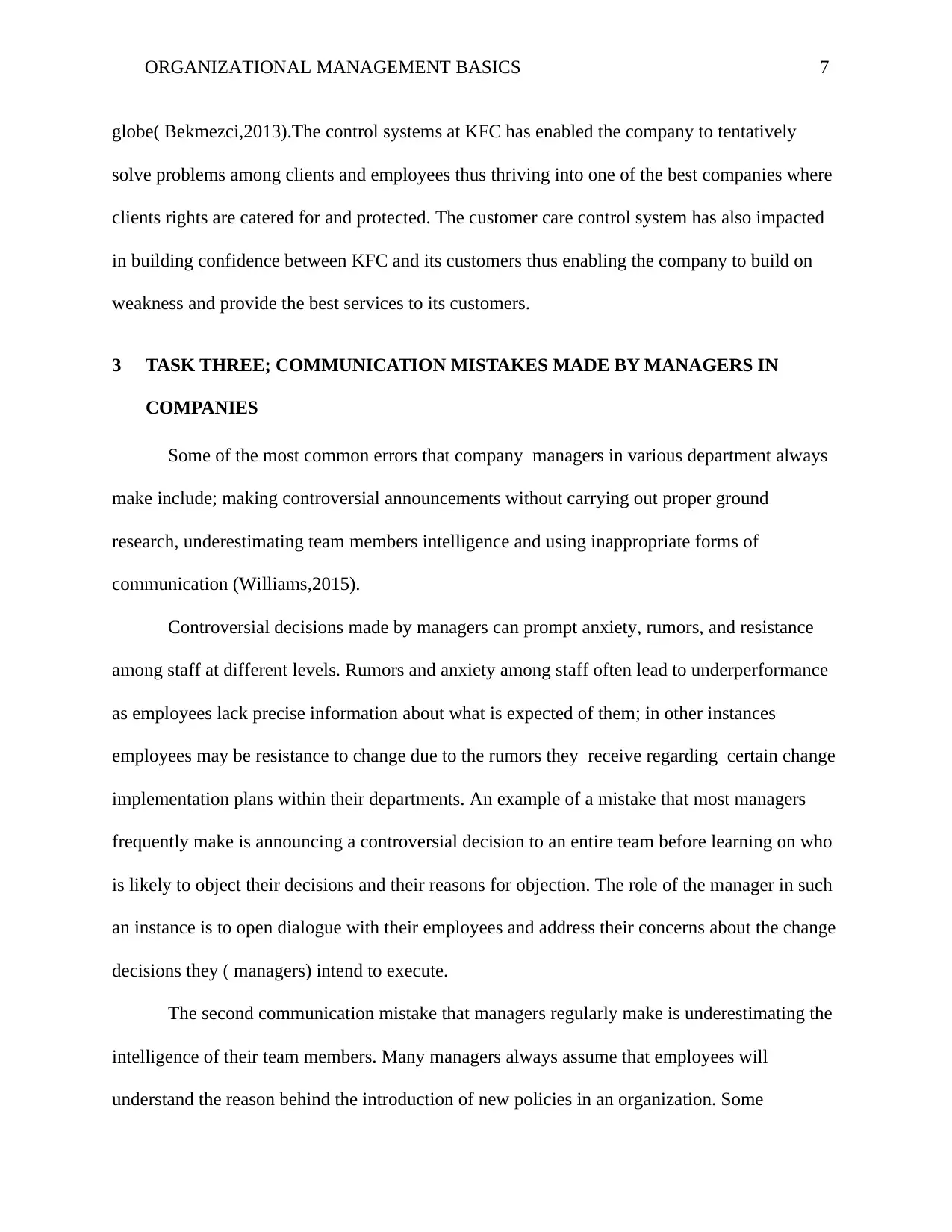
ORGANIZATIONAL MANAGEMENT BASICS 7
globe( Bekmezci,2013).The control systems at KFC has enabled the company to tentatively
solve problems among clients and employees thus thriving into one of the best companies where
clients rights are catered for and protected. The customer care control system has also impacted
in building confidence between KFC and its customers thus enabling the company to build on
weakness and provide the best services to its customers.
3 TASK THREE; COMMUNICATION MISTAKES MADE BY MANAGERS IN
COMPANIES
Some of the most common errors that company managers in various department always
make include; making controversial announcements without carrying out proper ground
research, underestimating team members intelligence and using inappropriate forms of
communication (Williams,2015).
Controversial decisions made by managers can prompt anxiety, rumors, and resistance
among staff at different levels. Rumors and anxiety among staff often lead to underperformance
as employees lack precise information about what is expected of them; in other instances
employees may be resistance to change due to the rumors they receive regarding certain change
implementation plans within their departments. An example of a mistake that most managers
frequently make is announcing a controversial decision to an entire team before learning on who
is likely to object their decisions and their reasons for objection. The role of the manager in such
an instance is to open dialogue with their employees and address their concerns about the change
decisions they ( managers) intend to execute.
The second communication mistake that managers regularly make is underestimating the
intelligence of their team members. Many managers always assume that employees will
understand the reason behind the introduction of new policies in an organization. Some
globe( Bekmezci,2013).The control systems at KFC has enabled the company to tentatively
solve problems among clients and employees thus thriving into one of the best companies where
clients rights are catered for and protected. The customer care control system has also impacted
in building confidence between KFC and its customers thus enabling the company to build on
weakness and provide the best services to its customers.
3 TASK THREE; COMMUNICATION MISTAKES MADE BY MANAGERS IN
COMPANIES
Some of the most common errors that company managers in various department always
make include; making controversial announcements without carrying out proper ground
research, underestimating team members intelligence and using inappropriate forms of
communication (Williams,2015).
Controversial decisions made by managers can prompt anxiety, rumors, and resistance
among staff at different levels. Rumors and anxiety among staff often lead to underperformance
as employees lack precise information about what is expected of them; in other instances
employees may be resistance to change due to the rumors they receive regarding certain change
implementation plans within their departments. An example of a mistake that most managers
frequently make is announcing a controversial decision to an entire team before learning on who
is likely to object their decisions and their reasons for objection. The role of the manager in such
an instance is to open dialogue with their employees and address their concerns about the change
decisions they ( managers) intend to execute.
The second communication mistake that managers regularly make is underestimating the
intelligence of their team members. Many managers always assume that employees will
understand the reason behind the introduction of new policies in an organization. Some
Paraphrase This Document
Need a fresh take? Get an instant paraphrase of this document with our AI Paraphraser
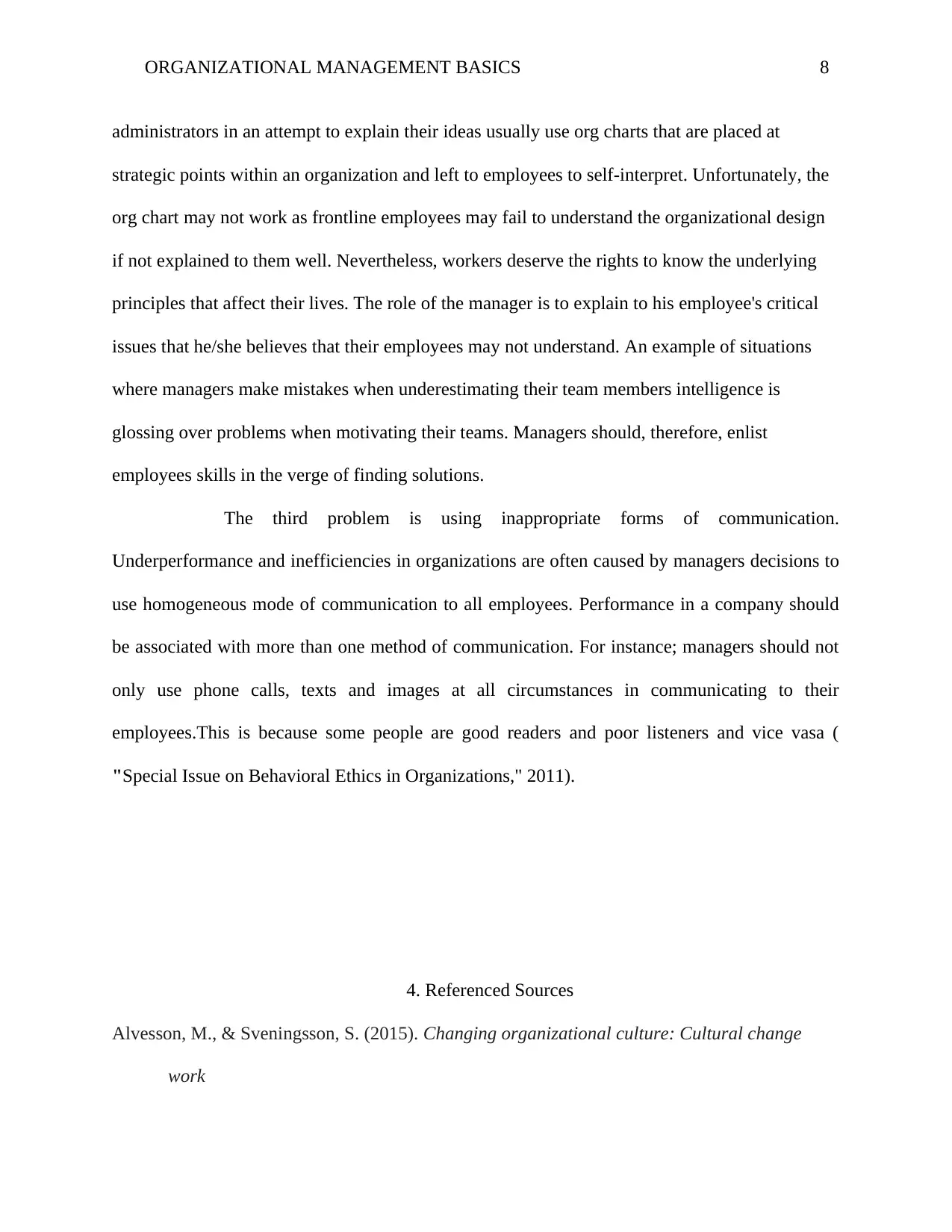
ORGANIZATIONAL MANAGEMENT BASICS 8
administrators in an attempt to explain their ideas usually use org charts that are placed at
strategic points within an organization and left to employees to self-interpret. Unfortunately, the
org chart may not work as frontline employees may fail to understand the organizational design
if not explained to them well. Nevertheless, workers deserve the rights to know the underlying
principles that affect their lives. The role of the manager is to explain to his employee's critical
issues that he/she believes that their employees may not understand. An example of situations
where managers make mistakes when underestimating their team members intelligence is
glossing over problems when motivating their teams. Managers should, therefore, enlist
employees skills in the verge of finding solutions.
The third problem is using inappropriate forms of communication.
Underperformance and inefficiencies in organizations are often caused by managers decisions to
use homogeneous mode of communication to all employees. Performance in a company should
be associated with more than one method of communication. For instance; managers should not
only use phone calls, texts and images at all circumstances in communicating to their
employees.This is because some people are good readers and poor listeners and vice vasa (
"Special Issue on Behavioral Ethics in Organizations," 2011).
4. Referenced Sources
Alvesson, M., & Sveningsson, S. (2015). Changing organizational culture: Cultural change
work
administrators in an attempt to explain their ideas usually use org charts that are placed at
strategic points within an organization and left to employees to self-interpret. Unfortunately, the
org chart may not work as frontline employees may fail to understand the organizational design
if not explained to them well. Nevertheless, workers deserve the rights to know the underlying
principles that affect their lives. The role of the manager is to explain to his employee's critical
issues that he/she believes that their employees may not understand. An example of situations
where managers make mistakes when underestimating their team members intelligence is
glossing over problems when motivating their teams. Managers should, therefore, enlist
employees skills in the verge of finding solutions.
The third problem is using inappropriate forms of communication.
Underperformance and inefficiencies in organizations are often caused by managers decisions to
use homogeneous mode of communication to all employees. Performance in a company should
be associated with more than one method of communication. For instance; managers should not
only use phone calls, texts and images at all circumstances in communicating to their
employees.This is because some people are good readers and poor listeners and vice vasa (
"Special Issue on Behavioral Ethics in Organizations," 2011).
4. Referenced Sources
Alvesson, M., & Sveningsson, S. (2015). Changing organizational culture: Cultural change
work
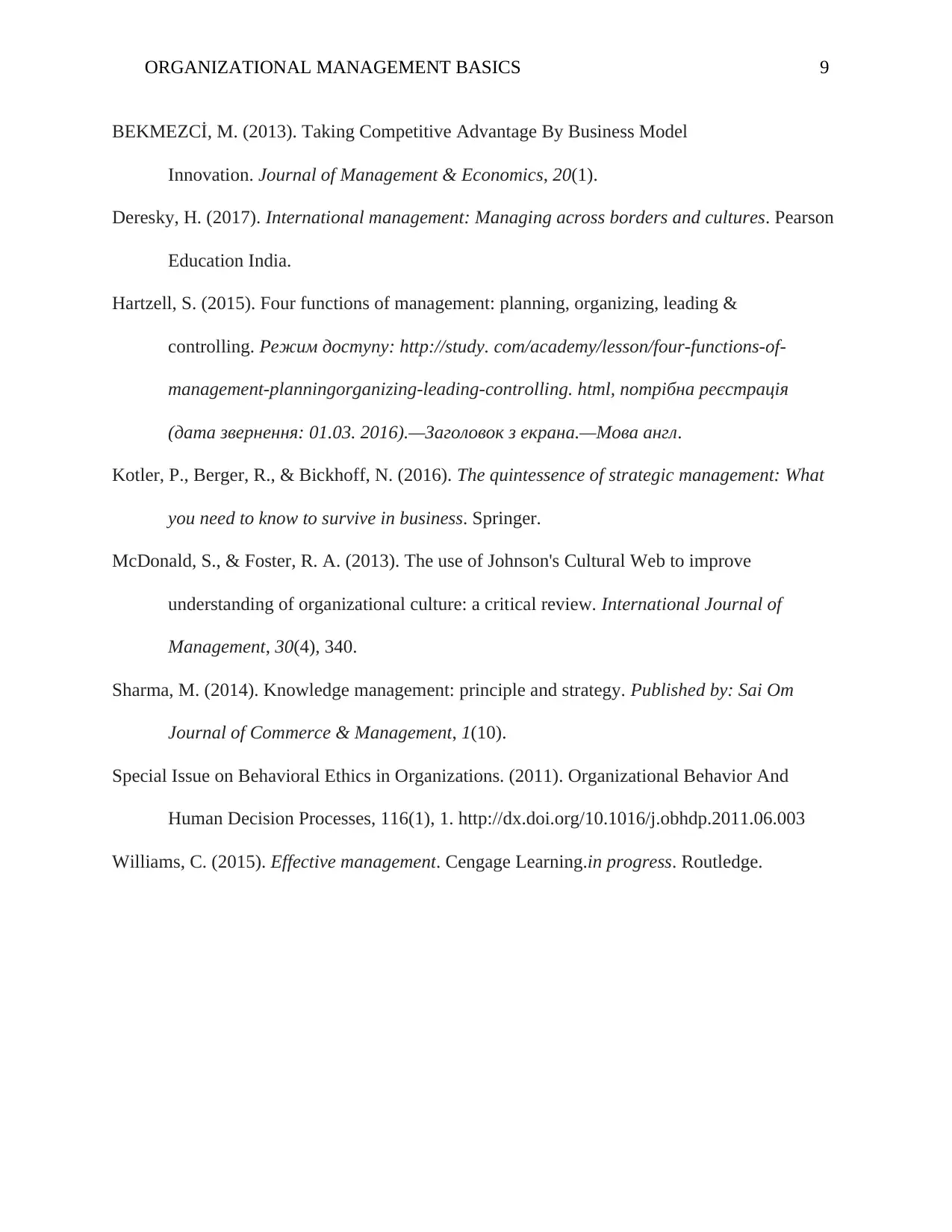
ORGANIZATIONAL MANAGEMENT BASICS 9
BEKMEZCİ, M. (2013). Taking Competitive Advantage By Business Model
Innovation. Journal of Management & Economics, 20(1).
Deresky, H. (2017). International management: Managing across borders and cultures. Pearson
Education India.
Hartzell, S. (2015). Four functions of management: planning, organizing, leading &
controlling. Режим доступу: http://study. com/academy/lesson/four-functions-of-
management-planningorganizing-leading-controlling. html, потрібна реєстрація
(дата звернення: 01.03. 2016).—Заголовок з екрана.—Мова англ.
Kotler, P., Berger, R., & Bickhoff, N. (2016). The quintessence of strategic management: What
you need to know to survive in business. Springer.
McDonald, S., & Foster, R. A. (2013). The use of Johnson's Cultural Web to improve
understanding of organizational culture: a critical review. International Journal of
Management, 30(4), 340.
Sharma, M. (2014). Knowledge management: principle and strategy. Published by: Sai Om
Journal of Commerce & Management, 1(10).
Special Issue on Behavioral Ethics in Organizations. (2011). Organizational Behavior And
Human Decision Processes, 116(1), 1. http://dx.doi.org/10.1016/j.obhdp.2011.06.003
Williams, C. (2015). Effective management. Cengage Learning.in progress. Routledge.
BEKMEZCİ, M. (2013). Taking Competitive Advantage By Business Model
Innovation. Journal of Management & Economics, 20(1).
Deresky, H. (2017). International management: Managing across borders and cultures. Pearson
Education India.
Hartzell, S. (2015). Four functions of management: planning, organizing, leading &
controlling. Режим доступу: http://study. com/academy/lesson/four-functions-of-
management-planningorganizing-leading-controlling. html, потрібна реєстрація
(дата звернення: 01.03. 2016).—Заголовок з екрана.—Мова англ.
Kotler, P., Berger, R., & Bickhoff, N. (2016). The quintessence of strategic management: What
you need to know to survive in business. Springer.
McDonald, S., & Foster, R. A. (2013). The use of Johnson's Cultural Web to improve
understanding of organizational culture: a critical review. International Journal of
Management, 30(4), 340.
Sharma, M. (2014). Knowledge management: principle and strategy. Published by: Sai Om
Journal of Commerce & Management, 1(10).
Special Issue on Behavioral Ethics in Organizations. (2011). Organizational Behavior And
Human Decision Processes, 116(1), 1. http://dx.doi.org/10.1016/j.obhdp.2011.06.003
Williams, C. (2015). Effective management. Cengage Learning.in progress. Routledge.
⊘ This is a preview!⊘
Do you want full access?
Subscribe today to unlock all pages.

Trusted by 1+ million students worldwide
1 out of 9
Related Documents
Your All-in-One AI-Powered Toolkit for Academic Success.
+13062052269
info@desklib.com
Available 24*7 on WhatsApp / Email
![[object Object]](/_next/static/media/star-bottom.7253800d.svg)
Unlock your academic potential
Copyright © 2020–2025 A2Z Services. All Rights Reserved. Developed and managed by ZUCOL.



